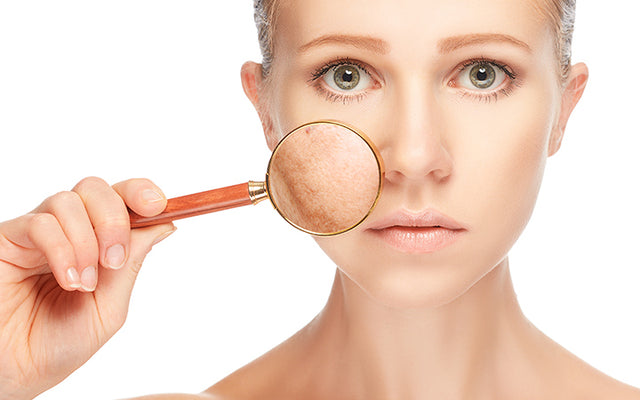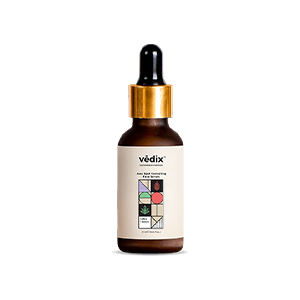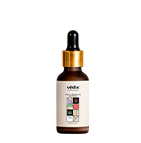Have you noticed large patches of darkened skin off late? Or have you experienced white patches on certain areas of your skin? These patches may indicate skin pigmentation disorders.
Skin pigmentation disorders can make your skin look uneven. Thankfully, with Ayurvedic solutions and remedies, you can eventually make the dark patches fade away.
Let’s take a closer look at what causes pigmentation on skin and how you can treat them effectively.

Highlights:
What Is Skin Pigmentation?
In simple terms, pigmentation means coloring. Your skin acquires its natural color from melanin, a pigment released by melanocyte cells in your skin. When melanin is not produced in required amounts or when it is produced excessively, you will notice an uneven distribution of your skin color. This is what we call it as a skin pigmentation disorder, caused by unhealthy or damaged melanocytes in your skin [1].
Your skin contains approximately 900-1500 melanocytes per square millimeter [2].
Types Of Skin Pigmentation Disorders
We can categorize skin pigmentation disorders into two types: Hyperpigmentation and hypopigmentation.
1. Hyperpigmentation
Hyperpigmentation is a condition in which patches of your skin become darker than the rest of the skin. This happens due to excessive production of melanin, which forms a bundle and gets deposited within your deeper skin tissues.

Some of the most common hyperpigmentation disorders are:
A. Melasma
Melasma develops as black or brown patches on your face. It is primarily caused by over-exposure to the sun.
B. Post Inflammatory Hyperpigmentation(PIH)
PIH [3] appears as black, brown, red or pink spots on your skin after any inflammatory conditions such as acne, pimple, rash, or a wound.
C. Periorbital Melanosis
Commonly known as ‘dark circles’ around your eyes, periorbital melanosis is primarily triggered by stressed or strained eyes.
D. Freckles
Freckles are a cluster of tiny spots that appear in black or brown color on your face. While they are usually caused by genetic factors, sun damage can too trigger the outbreak of freckles.
E. Photo-Melanosis
Photo-melanosis appears as a patchy pigmentation on your face, neck, arms, back, etc. It is caused by chronic sun exposure.
F. Sunburn
Sunburn appears as reddish or brownish skin pigmentation as a result of extensive sun damage on your skin.
G. Age spots
Also known as lentigines or liver spots, age spots develop as flat dark spots on your face, neck, arms, and decollete areas. “They are very common with aging and often appear in areas of your skin that are exposed to the sun,” says Dr. Zeel Gandhi, Chief Ayurvedic Doctor at Vedix.
2. Hypopigmentation
Hypopigmentation is a condition in which certain areas of your skin becomes lighter than the rest of your skin. It happens due to reduced melanin production in certain areas.

Some of the common hypopigmentation disorders are:
A. Vitiligo
In vitiligo, white or coppery pink patches appear on your skin due to the damage of melanocytes (pigment-producing cells) in certain areas of the skin. It is an autoimmune disorder.
B. Albinism
Albinism [4] is a rare inherited condition in which the skin is unable to produce melanin pigment. Simply put, people with such conditions have lack of skin pigmentation and their skin and hair appears white.
What Causes Pigmentation On Skin?
Common causes of hyperpigmentation
- Sun exposure
- Hormonal fluctuations
- Inflammation
- Age
- Injuries, etc.
Common causes of hypopigmentation
- Genetics
- Wrongful diets
- Skin infections such as eczema, contact dermatitis, tinea versicolor, etc.
- Sunburns & scars, etc.
Can Pigmentation Be Removed?
“If your skin pigmentation is superficial, it can be reduced with constant herbal treatments along with suitable diets and lifestyle practices. However, skin pigmentation at a deeper level may take longer periods to recover. And, some of them such as vitiligo or albinism may not be removed completely,” says Dr. Zeel.
How To Remove Skin Pigmentation?
1. Ayurvedic Herbal Treatment
As per Ayurveda, the functioning of your melanocytes and your skin color is governed by Bhrajaka Pitta dosha. When the Bhrajaka Pitta is in an imbalanced state, it leads to the vitiation of other doshas - Vata and Kapha too, which in turn results in different pigmentation disorders. Also, the accumulation of toxins (ama) in your body contributes to the pigmentation disorders in your skin.
Now, let’s find out different dosha-specific herbal treatments for both hyper and hypopigmentation disorders. You need to know which doshas are in the elevated state in your body before choosing the right herbs for treating your skin pigmentation.
-
For Hyperpigmentation
A. Kumkumadi Oil (saffron oil)
Massage your face and body with kumkumadi oil for 5 minutes daily half an hour before your bath. Take a bath with lukewarm water using a mild herbal cleanser. It helps to balance all three doshas.
B. Herbal bath
Prepare a paste by mixing 1 spoon of honey, 1 spoon of milk, and ¼ spoon of turmeric powder. Apply this paste to the affected areas with a gentle massage. Leave it for 20 minutes and then take a herbal bath. Add rose petals, a cup of grape juice or orange juice to the water. It balances all three doshas.
C. Yashtimadhu (Liquorice)
Prepare a fine paste by adding rosewater to ½ cup of licorice powder. Apply it to your pigmented face and wash it off after half an hour. Before removing the pack, you can scrub your face gently for a few minutes. It balances Pitta and Vata dosha.
D. Chandana (Sandalwood)
Prepare a fine paste by adding a spoon of orange juice to a spoon of sandalwood powder. Apply it to your spots and wash it off after half an hour with lukewarm water. It balances Pitta and Kapha dosha.
-
For Hypopigmentation
A. Bakuchi (Psoralea Corylifolia)
Mix bakuchi oil and coconut oil in equal quantities and apply it to the affected area. Stand in the morning sun for at least 5 minutes. Then wait for half an hour before you go for a shower. Use lukewarm water while bathing. It balances Vata and Kapha dosha.
B. Manjistha (Rubia Cordifolia)
You can swallow ¼-½ spoon of manjistha powder added with honey or water after your lunch and dinner. It is an effective blood purifier which aids in the removal of ama from your body. It balances Pitta and Kapha.
C. Neem (Azadirachta Indica)
Make a paste out of 10-12 neem leaves and add a spoon of curd to it. Apply it to the affected spots and wash it off after half an hour. It balances Pitta and Kapha.
D. Haritaki (Terminalia Chebula)
Prepare a paste by mixing a spoon of haritaki powder, ½ spoon of besan, and 2 spoons of rose water. Apply it to your face and leave it for half an hour. Later, wash it off with cool water. Haritaki aids in detoxifying your skin to a great extent. It balances all three doshas.
2. Home Remedies
-
For Hyperpigmentation
A. Onion:
Grate onion and form a thick-paste. Add a pinch of turmeric to it and mix well. Apply the mixture to the dark pigmented regions on your face. Wait for half an hour before washing it off using a mild cleanser.
B. Green tea:
Soak green tea leaves in cold water for an hour and strain the decoction. Now, use a cotton ball and apply the decoction all over your face. Wash it off after half an hour.
C. Tomato paste:
Apply tomato puree to the affected areas of your skin and wash it off with lukewarm water after 20 minutes.
D. Red lentils:
Soak 2-3 spoons of lentil seeds overnight and grind them into a fine paste in the morning. Apply it to the affected area with a gentle massage. Wash it off after half an hour.
E. Buttermilk:
Apply cold buttermilk on the dark spots using a cotton ball. Leave it for half an hour and then wash it off. You can also add a spoon of lemon juice to buttermilk if you have oily skin.
F. Apple cider vinegar:
Mix apple cider vinegar and water in equal amounts and apply it on your pigment spots. Leave it for half an hour before rinsing it with lukewarm water.
-
For Hypopigmentation
A. Papaya:
Rub some freshly cut papaya pieces on the affected areas of your skin for 5 minutes. Wait for half an hour before rinsing it off.
B. Turmeric and mustard oil:
Prepare a paste by adding some mustard oil to a spoon of turmeric powder. Apply it to the affected areas and wash it off using warm water after half an hour.
C. Ginger:
Take a freshly cut ginger slice and apply it directly to the affected areas of your skin. Leave it for 15-20 minutes before washing it off.
Vedix Tip: To treat your skin pigmentation problems (hyper or hypo), make a habit of applying freshly extracted aloe vera gel on the affected areas and leave it overnight. Wash it off in the morning.
3. Diet For Pigmentation
Your diet has a huge role in making your skin tone even [5]. Eating a well balanced healthy meal with fresh fruits and vegetables helps in maintaining the overall health of your skin.
A. For Hyperpigmentation
Include foods like oranges, cherries, papaya, grapes, avocado, carrots, capsicum, broccoli, etc. in your diet regularly.
B. For Hypopigmentation
Include foods such as leafy greens, carrots, beetroot, radish, bitter gourd, drumstick, chickpeas, figs, dates, apples, bananas, etc. in your diet regularly.
C. Foods To Avoid In Skin Pigmentation Conditions:
- Do not eat foods that are excessively sour, salty, and spicy.
- Avoid consuming opposite foods together. Eg: eating milk and fish together.
- Do not eat super hot or cold foods. Eat your food at a warm temperature.
- Never eat stale foods.
4. Vitamins For Pigmentation
-
For Hyperpigmentation
A. Vitamin C: It increases collagen production, which inhibits excessive melanin production in your skin.
B. Vitamin B12: Besides collagen production, Vitamin B12 aids in the growth of new cells in your skin.
C. Vitamin E: It is essential to treat pigmentation caused by scarring on your skin.
-
For Hypopigmentation
A. Vitamin A, C, And E: These vitamins help in preventing oxidative stress in your skin, which is one of the main causative factors for premature melanocyte destruction.
B. Vitamin B12 And Folic Acid: Vitamin B12 inhibits homocysteine production, which contributes to melanocytes destruction and impaired melanin synthesis. Vitamin B12 should be taken with folic acid, which acts as a methyl group donor for Vitamin B12.
C. Vitamin D: Besides improving the melanogenesis in your skin, Vitamin D helps in building a healthy immune system with a lower risk of autoimmune disorders.
Important Note:
You can get these essential vitamins through healthy and planned diets as per your skin pigmentation condition. If needed, you can consult your doctor for vitamin supplementation.
How To Prevent Skin Pigmentation?
A. Avoid exposing yourself to direct sunlight, especially between 10 am to 4 pm. You can use an umbrella, hat or mask to minimize your exposure to the sun.
B. Apply sunscreen lotion with SPF above 30 every day, even during gloomy days. Reapply them every 2-3 hours when you step out in the sun.
C. Minimize your habit of touching your skin every now and then. Even picking or scratching a mosquito bite can cause inflammation on your skin, which can lead to pigmentation.
D. Always wash your hands properly before applying your make-up or touching your face.
E. Do not sleep with makeup at night. Remove it completely before you hit the bed.
F. Drink around 8 glasses of water in a day and keep your skin adequately hydrated.
G. Do not share your items such as towels, gloves, footwear with others.
H. Involve in a regular exercise regimen. You can rely on yoga, meditation, and pranayama for reducing your stress levels.
I. Stay away from alcohol and smoking.
When To Seek Dermatologist’s Help For Pigmentation?
If your pigmentation issues do not seem to reduce even after regular herbal treatments for 2-3 months, then visit your dermatologist who can suggest suitable chemical and surgical treatments.
Important Note:
Ensure you seek your Ayurvedic doctor’s advice before applying any of the herbal treatments mentioned in the article on your skin.
The Last Word
Besides, severe sun exposure and genetics, many factors such as your wrongful dietary habits, stressful lifestyle, and improper skincare routine can contribute to your skin pigmentation problems. Ayurveda brings you holistic solutions which help you deal with your skin pigmentation disorders without side effects.
At Vedix, we analyze your elevated doshas and customize an Ayurvedic skincare regimen that resolves your unique skin concerns.
Know Your Dosha NowRecommended Products
Was this Article helpful?
- Least helpful
- Most helpful









